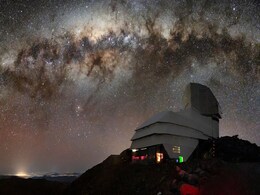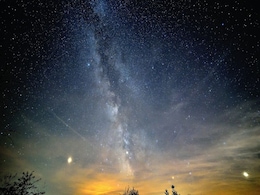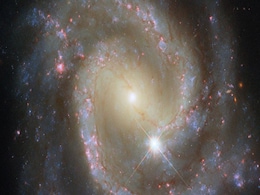Astronomy Night
- All
- News
- Videos
- Web Stories
-

8 Must-Visit Dark Sky Destinations For Astronomy Lovers
- Sunday August 31, 2025
- Travel | Written by Vaishali Kapila, Edited by Neha Grover
Stargazing has captivated humans for centuries, and while city life can make it hard to experience, there are still some incredible spots around the world where the night sky is as breathtaking as it's been for millennia.
-
 www.ndtv.com/travel
www.ndtv.com/travel
-

Perseid Meteor Shower 2025 to Dazzle Night Sky in August
- Wednesday August 13, 2025
- Written by Gadgets 360 Staff
The Perseid meteor shower, one of the year’s most anticipated celestial events, will peak on the night of August 12–13, 2025. At its height, the shower can produce up to 100 meteors per hour, though the glare of an 86% waning gibbous moon will make spotting faint streaks difficult. Observers can still expect to see the brightest meteors and occ...
-
 www.gadgets360.com
www.gadgets360.com
-

Light Pollution Threatens Global Observatories, Jeopardising Deep-Sky Astronomy
- Wednesday August 13, 2025
- Written by Gadgets 360 Staff
Light pollution is brightening skies over observatories at an alarming rate, with artificial light growing by up to 10% each year. Astronomers caution that this glow, intensified by widespread LED use and urban expansion, is threatening the ability of telescopes to detect faint cosmic objects and diminishing humanity’s shared right to experience ...
-
 www.gadgets360.com
www.gadgets360.com
-

Brightest Planets in June’s Night Sky: How and When to See Mercury, Venus, Mars and Saturn
- Monday June 2, 2025
- Written by Gadgets 360 Staff
Skywatchers can spot Mercury, Venus, Mars, and Saturn in prime June skies during dusk and dawn hours. With Mercury at its best visibility, Mars pairing with Regulus, and Venus and Saturn rising before sunrise, celestial highlights abound. A crescent moon joins Mars on June 29, making this month ideal for skywatching and astrophotography.
-
 www.gadgets360.com
www.gadgets360.com
-

Hubble Spots Isolated Barred Spiral Galaxy That’s Secretly Part of a Cosmic Duo
- Monday June 2, 2025
- Written by Gadgets 360 Staff
Hubble’s latest view features NGC 3507, a barred spiral galaxy in Leo, secretly traveling with its companion NGC 3501. Though only one is captured in the frame, both are spiral galaxies seen from different angles, offering a dual cosmic perspective. The image also reveals nearby stars and faint, distant galaxies across the backdrop of deep space.
-
 www.gadgets360.com
www.gadgets360.com
-

Polaris Wasn’t Always the North Star: How Earth’s Wobble Shifts the Celestial Pole
- Thursday May 22, 2025
- Written by Gadgets 360 Staff
Earth’s 26,000-year axial precession gradually shifts the celestial pole, replacing Polaris with new North Stars over millennia. Stars like Thuban, Kochab, Errai, and Vega have taken turns guiding humanity, and more will follow. According to NASA, gravitational forces cause this cosmic wobble, reminding us that even the seemingly constant night s...
-
 www.gadgets360.com
www.gadgets360.com
-

Canadian Astrophotographer Captures Stunning Sunflower Galaxy from Ontario
- Tuesday May 20, 2025
- Written by Gadgets 360 Staff, Edited by Rohan Pal
Astrophotographer Ronald Brecher has captured a magnificent image of Messier 63, famously known as the Sunflower Galaxy, from his backyard observatory in Guelph, Ontario. With over 13 hours of exposures taken using a Celestron 14" EDGE HD telescope and advanced imaging filters, the spiral galaxy’s fragmented arms and bright core are revealed in s...
-
 www.gadgets360.com
www.gadgets360.com
-

Vernal Equinox 2025: Date, Time, and the Science Behind the Event
- Friday March 7, 2025
- Written by Gadgets 360 Staff
The vernal equinox 2025 is set for March 20 at 09:01 UTC, marking the astronomical start of spring in the Northern Hemisphere and autumn in the Southern Hemisphere. This event occurs due to Earth’s axial tilt aligning with its orbit, resulting in nearly equal hours of daylight and night across the globe. While the equinox does not bring perfectly...
-
 www.gadgets360.com
www.gadgets360.com
-

T Coronae Borealis Nova Event: When and Where to See the 'Blaze Star'
- Wednesday March 5, 2025
- Written by Gadgets 360 Staff
T Coronae Borealis, also known as the 'Blaze Star,' is predicted to undergo a rare nova event, briefly making it visible to the naked eye. This recurrent nova, last seen erupting in 1946, is expected to brighten anytime between now and late 2024. Positioned in the constellation Corona Borealis, the star will be best visible a few hours after sunset...
-
 www.gadgets360.com
www.gadgets360.com
-

February 2025 Planet Parade: How to See Five Planets Align in the Sky
- Wednesday February 5, 2025
- Written by Gadgets 360 Staff
A rare celestial event will unfold in February 2025, with five bright planets—Venus, Jupiter, Mars, Mercury, and Saturn—visible in the evening sky. The highlight occurs on February 24, when Mercury and Saturn appear closest. Uranus and Neptune can also be observed with telescopes. Best viewing conditions require a clear west-southwest horizon a...
-
 www.gadgets360.com
www.gadgets360.com
-

Geminid Meteor Shower 2024 to Peak on December, But Moonlight May Affect Visibility
- Monday December 9, 2024
- Written by Gadgets 360 Staff
The Geminid meteor shower, renowned for its vibrant meteors, will peak overnight on December 13-14. However, a full moon on December 15 is expected to obscure much of the shower's activity, reducing visibility significantly. Limited dark sky windows are available in some regions before the peak, offering brief opportunities to observe this celestia...
-
 www.gadgets360.com
www.gadgets360.com
-

T Coronae Borealis' Nova Outburst May Happen Soon, Experts Suggest
- Tuesday December 3, 2024
- Written by Gadgets 360 Staff
Astronomers are closely monitoring T Coronae Borealis, a binary star system in the Corona Borealis constellation, for its next nova eruption. The event, expected within months, could light up the night sky as the white dwarf gathers material from its red giant companion, triggering a nuclear explosion. Advanced telescopes like NASA’s Fermi are ga...
-
 www.gadgets360.com
www.gadgets360.com
-

North Taurid Meteor Shower Peaks, Bringing Fireballs to US Night Skies
- Wednesday November 13, 2024
- Written by Gadgets 360 Staff
The North Taurid meteor shower, peaking November 11, offered skywatchers in the US a view of rare bright fireballs across the sky. Part of the Taurid meteor system, these meteors are known for their intensity and visibility, even under strong moonlight. Though fewer meteors occur in these showers, their brightness will make for a striking display o...
-
 www.gadgets360.com
www.gadgets360.com
-

November Night Sky 2024: Check Out the Brightest Planets and How to Watch Them?
- Monday November 4, 2024
- Written by Gadgets 360 Staff
November's night sky features a spectacular lineup of planets, including Venus, which becomes increasingly prominent in the west. Mars glows brightly as it approaches Earth, while Jupiter rises in the east, captivating observers with its brilliance. Saturn, with its magnificent rings, is also visible high in the southern sky. This month presents id...
-
 www.gadgets360.com
www.gadgets360.com
-

8 Must-Visit Dark Sky Destinations For Astronomy Lovers
- Sunday August 31, 2025
- Travel | Written by Vaishali Kapila, Edited by Neha Grover
Stargazing has captivated humans for centuries, and while city life can make it hard to experience, there are still some incredible spots around the world where the night sky is as breathtaking as it's been for millennia.
-
 www.ndtv.com/travel
www.ndtv.com/travel
-

Perseid Meteor Shower 2025 to Dazzle Night Sky in August
- Wednesday August 13, 2025
- Written by Gadgets 360 Staff
The Perseid meteor shower, one of the year’s most anticipated celestial events, will peak on the night of August 12–13, 2025. At its height, the shower can produce up to 100 meteors per hour, though the glare of an 86% waning gibbous moon will make spotting faint streaks difficult. Observers can still expect to see the brightest meteors and occ...
-
 www.gadgets360.com
www.gadgets360.com
-

Light Pollution Threatens Global Observatories, Jeopardising Deep-Sky Astronomy
- Wednesday August 13, 2025
- Written by Gadgets 360 Staff
Light pollution is brightening skies over observatories at an alarming rate, with artificial light growing by up to 10% each year. Astronomers caution that this glow, intensified by widespread LED use and urban expansion, is threatening the ability of telescopes to detect faint cosmic objects and diminishing humanity’s shared right to experience ...
-
 www.gadgets360.com
www.gadgets360.com
-

Brightest Planets in June’s Night Sky: How and When to See Mercury, Venus, Mars and Saturn
- Monday June 2, 2025
- Written by Gadgets 360 Staff
Skywatchers can spot Mercury, Venus, Mars, and Saturn in prime June skies during dusk and dawn hours. With Mercury at its best visibility, Mars pairing with Regulus, and Venus and Saturn rising before sunrise, celestial highlights abound. A crescent moon joins Mars on June 29, making this month ideal for skywatching and astrophotography.
-
 www.gadgets360.com
www.gadgets360.com
-

Hubble Spots Isolated Barred Spiral Galaxy That’s Secretly Part of a Cosmic Duo
- Monday June 2, 2025
- Written by Gadgets 360 Staff
Hubble’s latest view features NGC 3507, a barred spiral galaxy in Leo, secretly traveling with its companion NGC 3501. Though only one is captured in the frame, both are spiral galaxies seen from different angles, offering a dual cosmic perspective. The image also reveals nearby stars and faint, distant galaxies across the backdrop of deep space.
-
 www.gadgets360.com
www.gadgets360.com
-

Polaris Wasn’t Always the North Star: How Earth’s Wobble Shifts the Celestial Pole
- Thursday May 22, 2025
- Written by Gadgets 360 Staff
Earth’s 26,000-year axial precession gradually shifts the celestial pole, replacing Polaris with new North Stars over millennia. Stars like Thuban, Kochab, Errai, and Vega have taken turns guiding humanity, and more will follow. According to NASA, gravitational forces cause this cosmic wobble, reminding us that even the seemingly constant night s...
-
 www.gadgets360.com
www.gadgets360.com
-

Canadian Astrophotographer Captures Stunning Sunflower Galaxy from Ontario
- Tuesday May 20, 2025
- Written by Gadgets 360 Staff, Edited by Rohan Pal
Astrophotographer Ronald Brecher has captured a magnificent image of Messier 63, famously known as the Sunflower Galaxy, from his backyard observatory in Guelph, Ontario. With over 13 hours of exposures taken using a Celestron 14" EDGE HD telescope and advanced imaging filters, the spiral galaxy’s fragmented arms and bright core are revealed in s...
-
 www.gadgets360.com
www.gadgets360.com
-

Vernal Equinox 2025: Date, Time, and the Science Behind the Event
- Friday March 7, 2025
- Written by Gadgets 360 Staff
The vernal equinox 2025 is set for March 20 at 09:01 UTC, marking the astronomical start of spring in the Northern Hemisphere and autumn in the Southern Hemisphere. This event occurs due to Earth’s axial tilt aligning with its orbit, resulting in nearly equal hours of daylight and night across the globe. While the equinox does not bring perfectly...
-
 www.gadgets360.com
www.gadgets360.com
-

T Coronae Borealis Nova Event: When and Where to See the 'Blaze Star'
- Wednesday March 5, 2025
- Written by Gadgets 360 Staff
T Coronae Borealis, also known as the 'Blaze Star,' is predicted to undergo a rare nova event, briefly making it visible to the naked eye. This recurrent nova, last seen erupting in 1946, is expected to brighten anytime between now and late 2024. Positioned in the constellation Corona Borealis, the star will be best visible a few hours after sunset...
-
 www.gadgets360.com
www.gadgets360.com
-

February 2025 Planet Parade: How to See Five Planets Align in the Sky
- Wednesday February 5, 2025
- Written by Gadgets 360 Staff
A rare celestial event will unfold in February 2025, with five bright planets—Venus, Jupiter, Mars, Mercury, and Saturn—visible in the evening sky. The highlight occurs on February 24, when Mercury and Saturn appear closest. Uranus and Neptune can also be observed with telescopes. Best viewing conditions require a clear west-southwest horizon a...
-
 www.gadgets360.com
www.gadgets360.com
-

Geminid Meteor Shower 2024 to Peak on December, But Moonlight May Affect Visibility
- Monday December 9, 2024
- Written by Gadgets 360 Staff
The Geminid meteor shower, renowned for its vibrant meteors, will peak overnight on December 13-14. However, a full moon on December 15 is expected to obscure much of the shower's activity, reducing visibility significantly. Limited dark sky windows are available in some regions before the peak, offering brief opportunities to observe this celestia...
-
 www.gadgets360.com
www.gadgets360.com
-

T Coronae Borealis' Nova Outburst May Happen Soon, Experts Suggest
- Tuesday December 3, 2024
- Written by Gadgets 360 Staff
Astronomers are closely monitoring T Coronae Borealis, a binary star system in the Corona Borealis constellation, for its next nova eruption. The event, expected within months, could light up the night sky as the white dwarf gathers material from its red giant companion, triggering a nuclear explosion. Advanced telescopes like NASA’s Fermi are ga...
-
 www.gadgets360.com
www.gadgets360.com
-

North Taurid Meteor Shower Peaks, Bringing Fireballs to US Night Skies
- Wednesday November 13, 2024
- Written by Gadgets 360 Staff
The North Taurid meteor shower, peaking November 11, offered skywatchers in the US a view of rare bright fireballs across the sky. Part of the Taurid meteor system, these meteors are known for their intensity and visibility, even under strong moonlight. Though fewer meteors occur in these showers, their brightness will make for a striking display o...
-
 www.gadgets360.com
www.gadgets360.com
-

November Night Sky 2024: Check Out the Brightest Planets and How to Watch Them?
- Monday November 4, 2024
- Written by Gadgets 360 Staff
November's night sky features a spectacular lineup of planets, including Venus, which becomes increasingly prominent in the west. Mars glows brightly as it approaches Earth, while Jupiter rises in the east, captivating observers with its brilliance. Saturn, with its magnificent rings, is also visible high in the southern sky. This month presents id...
-
 www.gadgets360.com
www.gadgets360.com


















